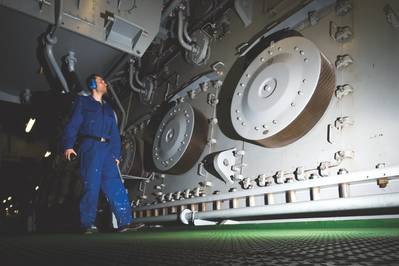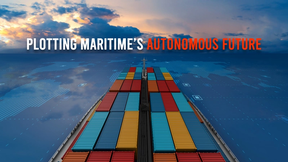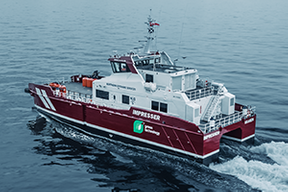Staying Afloat with Strong Workboat Insurance
When it comes to insuring your assets, changing markets and risk variables demand better understanding of the underwriting process, as well as a long-term, stable relationship with an insurer who – like you – is in for the long run.
U.S. inventor Thomas Edison once said, “There is no substitute for hard work.” Nobody knows this better than the men and women who operate diverse and industrious workboat fleets.
Ferrying commuters, towing dry and liquid bulk, and assisting larger ocean vessels maneuvering through more crowded ports only scratches the surface of the tasks performed by workboats and their crews. The work is hard and laborious, coupled with an environment that grows more challenging every day … and one that certainly needs appropriate precautions and protections in place.
Inherently Dangerous
As in any industry, accidents happen. Most will admit workboats are inherently dangerous places to work. From pulling a large barge to handling powerful equipment on choppy waters, serious accidents happen on a regular basis. One example is when a deckhand recently lost his lower left arm in a line handling accident in New York Harbor.
In 2016, the National Transportation Safety Board’s (NTSB) safety and information manual cited the most significant factors leading to workboat accidents include operator fatigue, use of medication, distractions such as cell phone usage, and errors in procedures when operating in a strong current.
Despite an overall steady downward trend in work boat accidents, the leading cause of death is falling overboard. According to the Coast Guard’s Maritime Commons blog, falls overboard account for approximately 50 percent of towing vessel fatalities.
Other Risk Factors
Workboat owners and operators find it increasingly difficult to hire the right talent. As in many industries, the maritime industry is dealing with an aging workforce and faces challenges in recruiting new talent. Workboats are not a typical 9-5 operation; instead they are often a 24-hour operation, requiring small crews to spend days or weeks aboard while taking turns sleeping and working. Finding the right talent is a pressure felt throughout the maritime industry. A shrinking workforce also translates to severe gaps in experience. And of course, inexperience poses significant risk.
Most workboat fleets are at least 40 to 50 years old, and built to traverse less complex lock and dams with smaller barges in tows. Over time they have been worn down and pushed to their brink, resulting in high repair costs and more time in “layup.” New-builds are too expensive to buy. Plus, re-builds – those with new propellers and engines – are generally just as effective as the new-builds. Aging boats require operator/owners to be especially vigilant in maintenance and upkeep to ensure the boats remain in good, working condition. Boats in layup are a drain on the balance sheet, so owners walk a fine line in ensuring new upgrades will make for more efficiency over a greater period of time.
'Consolidation is also having a major impact on the workboat industry. Most of today’s workboat operators are smaller, family-owned regional operators. With no succession plans in place for 10 to 15 years down the road, larger work boat operators are acquiring smaller regional operators. Such consolidation requires a careful look at how crews are integrated and how owners and operators are properly protecting newly acquired assets and crews.
The 411 on Insurance
Fortunately, whether it’s a single barge on the Mississippi, a fleet of towboats on the Ohio River or ferries shuttling commuters, a growing marine insurance industry is quite adept at tailoring coverage for workboats’ diverse needs. According to a recent market study released by Technavio, the global marine insurance market is projected to grow to $39.75 billion by 2021, at a Compound Annual Growth Rate of nearly 3 percent over the forecast period.
Growth opportunities have prompted many new entrants in the marine insurance market. Some sources estimate there are more than 100 marine insurers active today. More marine insurance carriers, alog with additional factors, have created a very competitive marketplace in recent years. As a result, workboat insurance rates – across all lines of cargo, hull & machinery, and marine liability – were on the decline. But as anyone in the maritime industry knows, winds change and particularly following the 2017 Hurricane Season, many anticipate that insurance rates will change direction too.
This Hurricane Season resulted in an early estimated $206 billion of losses in the insurance industry, which could bear the distinction of being the costliest hurricane season in US History. As most lines of insurance have been underpriced for years, insurers are seeking rates that are more realistic and sustainable for the risks that they are assuming.
It is also important for workboat owners and operators to evaluate potential insurers prior to making an insurance decision. It is important to evaluate the insurer’s longevity in the market space and track record. It is important to see how they have supported their maritime clients over time, and especially in the wake of a large loss event. Most insurers enter the maritime market when the going is good. After suffering losses, they tend to reevaluate and reconsider which lines of coverage they will underwrite. These market exits leave clients searching for other options.
As in any business arrangement, there are plenty of benefits in developing a long-term partnership. It certainly isn’t any different when partnering with an insurer. If an insurer has a longstanding commitment to the marine industry with seasoned marine underwriters, there is a greater degree of certainty that they are more cognizant of a workboat fleet’s risk profile, the perils they face every day, and the risks they see on the horizon.
Think like an Insurance Underwriter
Insurance underwriting is an analytical process. Especially when insuring workboats, all of which can be operated so differently and perform a wide array of duties, underwriters will perform a thoughtful analysis to accurate price a workboat’s risk.
Thinking like an underwriter can help workboat owners/operators not only better understand the insurance underwriting process, but also pinpoint areas on which to focus risk management/loss prevention efforts. Thinking like an insurance underwriter will help you get the best coverage for the best price. Here are basic areas to think about:
- Maintenance: Are the engine and other mechanical parts in good repair? Is safety equipment stowed on boards and easily accessible if needed? Do you have an ongoing Safety Program in place?
- The crew: Is the crew skilled and knowledgeable? Do crew members have the right paperwork? Do you provide proper training and incentivize your crew for promoting a Safety Culture?
- Operations: What kind of services/operations does the fleet provide? Do you have an Operations Director or Risk Manager?
- Navigation area: What risks are posed by the workboat’s working environment? Are they working the coasts or just the inland rivers? Do you know that some jurisdictions in which you operate are more litigious than others?
- Value: Is the valuation correct on your vessels? What upkeep procedures are in place to ensure that operating equipment fits the job? Are your Condition & Valuations up to date?
- Risk management response: What are a fleet’s claims trends and frequencies? When something happens, how well does the owner/operator get to the root cause of the loss? How does the company respond to these causes? What’s done to make a correction or take a precaution?
Other things to consider when building an insurance program that works right for a workboat fleet is risk retention. Challenge underwriters to propose deductible options. Strong consideration is often given to those insureds who want to have “skin in the game.” Especially as insurance rates begin to change direction, more maritime companies may be looking to retain more risk to balance potentially increasing rates.
Also, determine what loss prevention services the insurance carrier will provide. Often these are provided at no additional cost. They can reveal an unidentified exposure or validate that your current procedures are sound.
Maritime risks are growing ever more complex. Bigger vessels are moving larger volumes of cargo moving around the globe into much busier ports. And workboats are often right on the front lines of it all. To protect your interests, partner with committed marine insurers and brokers to make the insurance buying process more efficient and easier to navigate.
(As published in the May 2018 edition of Marine News)














